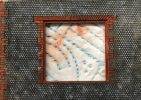david bigcheeseplant
Western Thunderer
Once I am happy with the design I will export the files to the laser cutter to create a kit of parts. I have a number of official GWR drawings plus the 1:500 1875 town plan plus the CAD drawings of a survey on the building made about 15 years ago. So I hope what I have created is pretty accurate, as I have been counting brick etc, as the flint and brick pattern I want to get right.
David





